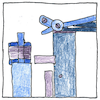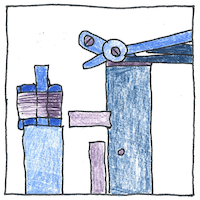Louis-Bernard Guyton de Morveau,
John Frederic Daniell
thermometry

|
Platinum pyrometer
Louis-Bernard Guyton de Morveau realized that thermal expansion of a metal could provide an alternative to Wedgwood’s method of determining high temperatures, and Guyton had worked with platinum for years. He placed a bar of platinum in a small ceramic trough open at one end and closed on the other, and he fixed this on a platinum plate so that the platinum bar pressed the short arm of a small platinum lever whose longer arm moved across a scaled platinum arc. * Guyton calibrated his platinum pyrometer with a mercury thermometer at low temperatures and compared Wedgwood’s pyrometer at higher temperatures. Although he showed that Wedgwood’s readings were too high, he concluded that Wedgwood’s pyrometer was more practical. Guyton’s delicate platinum spring and lever likely bent and fused at temperatures above the melting point of antimony. * In 1830, John Frederic Daniell improved Guyton’s pyrometer by separating the heated parts, placing the expanding bar in a cylinder of graphite. After removing these from immersion in molten metals, he clipped a lever and dial on them to measure the thermal expansion of the bar.
Daniell’s Register-Pyrometer
On a new Register-Pyrometer, for measuring the Expansions of Solids, and determining the higher Degrees of Temperature upon the common thermometric scale by J. Frederic Daniell, Esq., F.R.S.
Practical problems
The main trouble was the darned metal got soft. Also, like Wedgwood’s scale, it could be calibrated only at low temperatures. Well, practical problems typically accompany any attempt to venture into an unexplored space. One reason for ignorance—it ain’t easy, even though the promise of knowledge leads many to risk failure.



Guyton’s pyrometer was essentially the same as Ferguson’s; however, whereas Ferguson intended his to measure the relative thermal expansions of different metals, Guyton intended his to measure absolute temperatures.
See also in The book of science:
Readings in wikipedia:
Other readings: